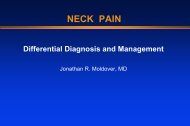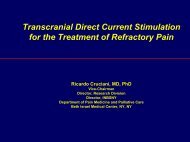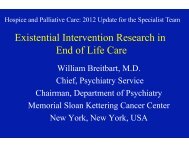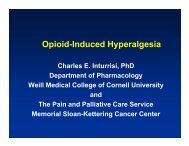delirium in the cancer patient - Department of Pain Medicine and ...
delirium in the cancer patient - Department of Pain Medicine and ...
delirium in the cancer patient - Department of Pain Medicine and ...
You also want an ePaper? Increase the reach of your titles
YUMPU automatically turns print PDFs into web optimized ePapers that Google loves.
Delirium <strong>in</strong> Advanced Cancer• Delirium is under-recognized <strong>and</strong> under-treated.• One <strong>of</strong> <strong>the</strong> barriers to adequate cl<strong>in</strong>ical <strong>in</strong>tervention <strong>in</strong><strong>delirium</strong> is <strong>the</strong> lack <strong>of</strong> appreciation for <strong>the</strong> distressexperienced by <strong>patient</strong>s with <strong>delirium</strong> , as well as <strong>the</strong>impact <strong>of</strong> <strong>delirium</strong> on spouses/caregivers <strong>and</strong> staff.• We suspect that <strong>patient</strong>s with hypoactive <strong>delirium</strong> areperceived to be <strong>in</strong> less distress than agitated <strong>patient</strong>swith hyperactive <strong>delirium</strong>.
DSM-IV Criteria for DeliriumA. Disturbance <strong>of</strong> consciousness (i.e., disturbance<strong>of</strong> awareness <strong>of</strong> <strong>the</strong> environment) with reduced abilityto focus, susta<strong>in</strong> or shift attentionB. Change <strong>in</strong> cognition (such as memory deficit,disorientation, language disturbance, perceptualdisturbance) that is not better accounted for by a preexist<strong>in</strong>g,established or evolv<strong>in</strong>g dementia
DSM-IV Criteria for Delirium (Con’t)C. The disturbance evolves over a short period <strong>of</strong> time(usually hours to days) <strong>and</strong> tends to fluctuate dur<strong>in</strong>g <strong>the</strong>course <strong>of</strong> <strong>the</strong> dayD. There is evidence from <strong>the</strong> history, physicalexam<strong>in</strong>ation,or laboratory f<strong>in</strong>d<strong>in</strong>gs <strong>of</strong> a general medicalcondition judged to be etiologically related to <strong>the</strong>disturbance
Subtypes <strong>of</strong> DeliriumDelirium is a disturbance <strong>of</strong> arousal<strong>and</strong> cognition.Subtypes <strong>of</strong> <strong>delirium</strong> are based on <strong>the</strong> type <strong>of</strong> arousaldisturbance:HyperactiveHypoactiveMixed
Hypoactive Delirium: Controversies <strong>and</strong>Barriers to Treatment• Hypoactive Delirium is thought to be very rare, but <strong>in</strong> factaccounts for an average <strong>of</strong> 50% <strong>of</strong> <strong>delirium</strong> cases• Hypoactive Delirium is thought not to cause morbidity <strong>and</strong><strong>the</strong>refore does not require pharmacologic <strong>in</strong>tervention.• Hypoactive Delirium, because <strong>of</strong> its phenomenologicdifferences with Hyperactive Delirium, is thought not torespond to pharmacologic <strong>in</strong>terventions with neuroleptics
Objectives• To describe <strong>the</strong> experience <strong>of</strong> <strong>delirium</strong> <strong>in</strong> hospitalized<strong>cancer</strong> <strong>patient</strong>s.• To exam<strong>in</strong>e <strong>the</strong> level <strong>of</strong> distress related to <strong>the</strong> <strong>delirium</strong>experience <strong>in</strong> <strong>cancer</strong> <strong>patient</strong>s, <strong>the</strong>ir spouses/caregivers,<strong>and</strong> nurses.• To exam<strong>in</strong>e <strong>the</strong> relationships among <strong>delirium</strong>-relateddistress, <strong>delirium</strong> phenomenology, etiology,demographic <strong>and</strong> medical variables.
Delirium Experience Questionnaire• Do you remember be<strong>in</strong>g confused? Yes__ No__• If no, are you distressed that you can’t remember? Yes_ No_• How distressed? 0-4 numerical rat<strong>in</strong>g scale (NRS)• If yes, was <strong>the</strong> experience distress<strong>in</strong>g? Yes__ No__• How distress<strong>in</strong>g? 0-4 NRS• Can you describe <strong>the</strong> experience?• Spouse /Caregiver: How distressed were you dur<strong>in</strong>g <strong>the</strong> <strong>patient</strong>’s<strong>delirium</strong>? 0-4 NRS• Nurse: Your <strong>patient</strong> was confused. Did you f<strong>in</strong>d it distress<strong>in</strong>g?0-4 NRS• 0-4NRS: 0: not at all, 4: extremely
Sample Characteristics (n= 101)• Mean Age: 58.36 years (SD= 16.6)• Gender: Males= 52; Females= 49• Race: White= 67%; Black= 21%; Hispanic= 9%;O<strong>the</strong>r=3%• Cancer Diagnoses: Lung-21%, GI-14%,Lymphoma-13%Breast-11%, Head <strong>and</strong> Neck-6%, Ovarian-4%, Bra<strong>in</strong>-3%,O<strong>the</strong>r <strong>cancer</strong>s- 28%• Stage: Localized=16%, Metastatic=79%, Term<strong>in</strong>al=5%• Bra<strong>in</strong> Metastases: 24%; History <strong>of</strong> Dementia: 18%• Karn<strong>of</strong>sky: Mean= 35.5 (SD=7.7)
Sample Characteristics (n= 101)• Memorial Delirium Assessment Scale (MDAS):Mean MDAS = 19 (SD 3.2), range 14-30• Delirium Subtypes: Hypoactive= 53%; Hyperactive=47%• Delirium Etiologies:Multiple causes= 74%; S<strong>in</strong>gle cause= 26%• Delirium Etiologies encountered:Opioids-65%, <strong>in</strong>fection-39% steroids-30%,hypoxia-26%, dehydration-12%, CNS-12%,O<strong>the</strong>r-13%
Results• 53.5% <strong>of</strong> <strong>patient</strong>s (N=54) who recovered from <strong>delirium</strong>remember be<strong>in</strong>g delirious.• 93% <strong>of</strong> <strong>patient</strong>s who remember be<strong>in</strong>g delirious report <strong>the</strong>experience as be<strong>in</strong>g “distress<strong>in</strong>g”.• Mean level <strong>of</strong> <strong>patient</strong> distress (0-4 NRS)= 3.22 (SD=.86)• Mean level <strong>of</strong> Spouse/Caregiver distress= 3.75 (SD=.47)• Mean level <strong>of</strong> Nurse distress= 3.09 (SD=.77)
Percentage <strong>of</strong> Patients with Delirium RecallBased Upon Delirium Severity .10090807060504030201001005516Severe Moderate Mild% <strong>of</strong> Patientswith DeliriumRecall
Logistic Regression Analysis <strong>of</strong> Predictors <strong>of</strong>Patient, Spouse/Caregiver, <strong>and</strong> Nurse DistressVariable P ORPatient DistressDelusions .05 7.9Spouse/Caregiver DistressKarn<strong>of</strong>sky (KPS) .003 9.1Nurse DistressMDAS Total Score .01 5.2Perceptual disturbances .04 3.6OR = Odds Ratio
Distress <strong>in</strong> Hyperactive vs HypoactiveDelirium• There were no significant differences <strong>in</strong> <strong>the</strong> report<strong>of</strong> distress for <strong>patient</strong>s, or nurses based on subtype<strong>of</strong> <strong>delirium</strong>. Spouses/caregivers were moredistressed by hypoactive <strong>delirium</strong>.• Hypoactive <strong>delirium</strong> was equally as distress<strong>in</strong>g asHyperactive <strong>delirium</strong> for <strong>patient</strong>s, nurses.
Summary: Delirium Experience• Delirium is a highly distress<strong>in</strong>g experience for <strong>patient</strong>s,spouses/ caregivers <strong>and</strong> nurses• Delirium is especially distress<strong>in</strong>g when <strong>delirium</strong> is moresevere <strong>and</strong> is characterized by <strong>the</strong> presence <strong>of</strong> delusions<strong>and</strong> halluc<strong>in</strong>ations• Hypoactive <strong>delirium</strong> is as distress<strong>in</strong>g as hyperactive<strong>delirium</strong>• Delirium is important to treat because it is associatedwith significant suffer<strong>in</strong>g not only <strong>in</strong> <strong>patient</strong>s, but also <strong>in</strong>spouses/caregivers <strong>and</strong> staff
Delirium Assessment MethodsDiagnostic classification systemsDSM-III, DSM-III-R, DSM-IVICD-9, ICD-10Diagnostic <strong>in</strong>terview <strong>in</strong>strumentsDelirium symptom <strong>in</strong>terview (DS)Confusion Assessment Method (CAM)Delirium rat<strong>in</strong>g scalesDelirium Rat<strong>in</strong>g Scale (DRS)Confusion Rat<strong>in</strong>g Scale (CRS)Memorial Delirium Assessment Scale (MDAS)Cognitive impairment screen<strong>in</strong>g scalesM<strong>in</strong>i-Mental State Exam (MMSE)Short Portable Mental Status Questionnaire (SPMSQ)Cognitive Capacity Screen<strong>in</strong>g Exam<strong>in</strong>ation Test (BOMC)
Memorial Delirium Assessment Scale (MDAS)• REDUCED LEVEL OF CONSCIOUSNESS (AWARENESS)• DISORIENTATION• SHORT-TERM MEMORY IMPAIRMENT• IMPAIRED DIGIT SPAN• REDUCED ABILITY TO MAINTAIN AND SHIFT ATTENTION• DISORGANIZED THINKING• PERCEPTUAL DISTURBANCE• DELUSIONS• DECREASED OR INCREASED PSYCHOMOTOR• SLEEP-WAKE CYCLE DISTURBANCE (DISORDER OF AROUSALBreitbart, et al, JPSM, 1996
Validation <strong>of</strong> <strong>the</strong> Memorial DeliriumAssessment Scale <strong>in</strong> <strong>the</strong> Term<strong>in</strong>ally Ill• The MDAS is a 10 item <strong>delirium</strong> severity <strong>and</strong> diagnostic<strong>in</strong>strument designed for repeated assessment <strong>and</strong> treatmentevaluation• Two validation studies have been conducted to date us<strong>in</strong>g largesamples <strong>of</strong> hospitalized <strong>cancer</strong> <strong>and</strong> AIDS <strong>patient</strong>s as well as <strong>cancer</strong><strong>patient</strong>s admitted to a palliative care unit• The MDAS is highly correlated with o<strong>the</strong>r diagnostic measures <strong>of</strong><strong>delirium</strong> (e.g. <strong>the</strong> DRS) <strong>and</strong> cognition (e.g. <strong>the</strong> MMSE)• Diagnostic cut-<strong>of</strong>f scores <strong>of</strong> 13/30 <strong>in</strong> hospitalized <strong>cancer</strong> <strong>patient</strong>s,<strong>and</strong> 7/30 <strong>in</strong> PCU <strong>patient</strong>s have been suggested• Prorat<strong>in</strong>g item scores is necessary <strong>in</strong> up to 20% <strong>of</strong> <strong>patient</strong>sBreitbart,W, et al 1996; Lawlor, P, et al 2000
Overview <strong>of</strong> Delirium ManagementDELIRIUM TREATMENT OUTCOMEPreTerm<strong>in</strong>alDeliriumTerm<strong>in</strong>alDeliriumAimed atrevers<strong>in</strong>getiologyAimed atcontroll<strong>in</strong>gsymptomatologyDelirium isreversibleDeliriumis irreversible
Assessment <strong>of</strong> Etiologies <strong>of</strong> Delirium<strong>in</strong> Advanced Cancer Patients• Unclear or never discovered <strong>in</strong> over 50% <strong>of</strong> <strong>patient</strong>s• Three or more etiologies usually present• Irreversible 30-40% <strong>of</strong> <strong>the</strong> time, especially <strong>in</strong> <strong>the</strong>term<strong>in</strong>ally ill• Etiology found <strong>in</strong> 40% - 50% <strong>of</strong> cases– 30% - 70% improve with treatment <strong>of</strong> etiology
Assessment <strong>of</strong> Etiologies <strong>of</strong> Delirium<strong>in</strong> <strong>the</strong> Advanced Cancer Patient (cont’d)• Diagnostic work-up must be consistent with <strong>the</strong> goals<strong>of</strong> care—m<strong>in</strong>imally <strong>in</strong>vasive <strong>in</strong> <strong>the</strong> term<strong>in</strong>ally ill—treatments are effective <strong>and</strong>/or m<strong>in</strong>imallyburdensome or distress<strong>in</strong>g
Causes <strong>of</strong> Delirium <strong>in</strong> Advanced CancerDirectPrimary bra<strong>in</strong> tumorMetastatic spreadIndirectHypoxiaMetabolic encephalopathy due to organ failureElectrolyte imbalanceWithdrawal states
Causes <strong>of</strong> Delirium <strong>in</strong> Cancer Patients (cont’d)Indirect (cont’d)Treatment side effects fromChemo<strong>the</strong>rapeutic agents, steroids,biological response modifiersRadiationOpioidsAntichol<strong>in</strong>ergicsAntiemeticsInfectionHematologic abnormalitiesNutritional deficienciesParaneoplastic syndromes
Non-Pharmacological Interventions forDelirium <strong>in</strong> <strong>the</strong> Advanced Cancer Patient1. Provide safe <strong>and</strong> supportive environment for <strong>patient</strong>,staff, <strong>and</strong> family2. Reassure family <strong>of</strong> <strong>the</strong> medical nature <strong>of</strong> <strong>delirium</strong>Their family member is not “hav<strong>in</strong>g a nervousbreakdown”3. Depend<strong>in</strong>g on stage <strong>of</strong> disease, ei<strong>the</strong>r reassurefamily <strong>of</strong> transient nature <strong>of</strong> <strong>delirium</strong> or describe as ahallmark <strong>of</strong> approach<strong>in</strong>g death
Non-Pharmacological Interventions forDelirium <strong>in</strong> Advanced Cancer (cont’d)4. Provide proper sensory environment for <strong>patient</strong>— quiet, well-lit room— visible clock, calendar— familiar people, objects5. Communicate with <strong>patient</strong> <strong>and</strong> family— goals <strong>of</strong> care <strong>and</strong> desirable outcomes, i.e.,sedation vs. awake but agitated— regard<strong>in</strong>g halluc<strong>in</strong>ations <strong>and</strong> <strong>the</strong>ir management ormean<strong>in</strong>g
Pharmacological Management <strong>of</strong> DeliriumApproximate dailyGeneric Name dosage range (mg) RouteNeurolepticsHaloperidol 0.5-5 q2-12h PO, IV, SC, IMThioridaz<strong>in</strong>e 10-75 q4-8h POChlorpromaz<strong>in</strong>e 12.5-50 q4-12h PO, IV, IMMethotrimepraz<strong>in</strong>e 12.5-50 q4-8h IV, SC, PODroperidol 0.5-5 q12h IM, IVMol<strong>in</strong>done 10-50 q8-12h PO
Pharmacological Management <strong>of</strong> DeliriumApproximate dailyGeneric Name dosage range (mg) RouteAtypical AntipsychoticsRisperidone 1-3 q12h POOlanzap<strong>in</strong>e 2.5-5 q12h PO/IMQuetiap<strong>in</strong>e 25-150 q12h POZiprasidone 20-80 q12h PO/IMAripiprazolee 10-15 qd PO
Side Effects <strong>of</strong> Neuroleptics/AntipsychoticsAntichol<strong>in</strong>ergicDry MouthConstipationCardiovascular (BP, QT <strong>in</strong>terval)Antihistam<strong>in</strong>icSedation, Weight Ga<strong>in</strong>Dopam<strong>in</strong>e BlocadeExtrapyramidal Side EffectsHyperprolct<strong>in</strong>emiaNeuroleptic Malignant Syndrome
Side Effects <strong>of</strong> Atypical AntipsychoticsMetabolic SyndromeHyperglycemiaHyperlipidemiaWeight Ga<strong>in</strong>Olanzap<strong>in</strong>e <strong>and</strong> Clozap<strong>in</strong>ehave highest <strong>in</strong>cidenceQT Interval ProlongationTorsade des Po<strong>in</strong>tesQTc prolongation beyond 500msecECG should be monitored daily dur<strong>in</strong>g <strong>delirium</strong> RXConsider <strong>in</strong>teractions with o<strong>the</strong>r agents that prolong QT
Side Effects <strong>of</strong> Haloperidol vs.Risperidone vs. Olanzap<strong>in</strong>eSide Effect Haloperidol Risperidone Olanzap<strong>in</strong>eEPS >30% >10% >2%ACHE >2% >2% >10%Sedation >2% >10% >30%Hypotension >2% >30% >2%Seizure >2% >2% >2%Bezchlibnyk-Butler & Jeffries, 1999
Neurotransmitter/Receptor Effects<strong>of</strong> Antipsychoticsα15HT2Aα1α25HT2AM1 H1α1haloperidolrisperidone5HT2C5HT3olanzap<strong>in</strong>eD1D25HT7D25HT6D4D3D2
Cl<strong>in</strong>ical Trials <strong>of</strong> Delirium ManagementA double-bl<strong>in</strong>d, r<strong>and</strong>omized trial <strong>of</strong> Haloperidol vs.Chlorpromaz<strong>in</strong>e vs. Lorazepam <strong>in</strong> <strong>the</strong> treatment <strong>of</strong> <strong>delirium</strong> <strong>in</strong>medically hospitalized AIDS <strong>patient</strong>s with AIDS-related<strong>cancer</strong>s (N=244 screened, 30 on trial.)Results:• Both Haloperidol <strong>and</strong> Chlorpromaz<strong>in</strong>e were effective <strong>in</strong>rapidly resolv<strong>in</strong>g <strong>the</strong> symptoms <strong>of</strong> <strong>delirium</strong> utiliz<strong>in</strong>g lowdosage regimens• Lorazepam alone was <strong>in</strong>effective• No cl<strong>in</strong>ically significant side effects• Both hypoactive <strong>and</strong> hyperactive <strong>delirium</strong> responded toneurolepticsBreitbart et al Am J Psy 1996
AIDS Delirium StudyDose Haloperidol Chlorpromaz<strong>in</strong>e Lorazepam1 0.25 mg 10 mg 0.5 mg2 0.5 mg 20 mg 1.0 mg3 1.0 mg 40 mg 1.5 mg4 2.0 mg 80 mg 2.0 mg5 2.5 mg 100 mg 2.5 mg6 2.5 mg 100 mg 2.5 mg7 2.5 mg 100 mg 2.5 mg8 5.0 mg 200 mg 4.0 mg9 5.0 mg 200 mg 4.0 mgMax 21.25 mg 850 mg 20.5 mgAll doses PO; Dose IM = 1/2 PO
AIDS Delirium StudyDrug Dosages1st 24 hoursHaloperidolChlorpromaz<strong>in</strong>eLorazepammean dose 2.6 mgmedian dose 1.75 mgrange .75-6.25 mgmean dose 100 mgmedian dose 70 mgrange 30-257.5 mgmean dose 6.9 mgmedian dose 3.0 mgrange 0.5-20 mg
AIDS Delirium StudyDrug DosagesMa<strong>in</strong>tenance Dose Days 2 - 7Haloperidolmean dose 1.6 mgmedian dose 1.0 mgrange 0.25 – 4.375 mgChlorpromaz<strong>in</strong>eLorazepammean dose 40 mgmedian dose 35 mgrange 15 – 175 mgmean dose 1.5 mgmedian dose 1.25 mgrange 1.25 – 2.0 mg
Neuroleptics for Hypoactive Delirium• Both Haloperidol <strong>and</strong> Chlorpromaz<strong>in</strong>e wereeffective <strong>in</strong> improv<strong>in</strong>g <strong>the</strong> symptoms <strong>of</strong><strong>delirium</strong> (as measured by <strong>the</strong> DRS) for bothhyperactive (N=9), F=19.06, df=1.18,p
An Open Trial <strong>of</strong> Olanzap<strong>in</strong>e for <strong>the</strong>Treatment <strong>of</strong> Delirium <strong>in</strong> HospitalizedCancer PatientsWilliam Breitbart,M.D.Annie Tremblay, M.D.Christopher Gibson, Ph.D.Memorial Sloan-Ketter<strong>in</strong>g Cancer Center
Efficacy <strong>of</strong> Olanzap<strong>in</strong>e <strong>in</strong> <strong>the</strong> Treatment <strong>of</strong>DeliriumMDAS Score20181614121086420Basel<strong>in</strong>e Time 1 Time 2t (basel<strong>in</strong>e-Time3) = 10.1, p < .001
Results- Olanzap<strong>in</strong>e Efficacy• Two MDAS cut-<strong>of</strong>f scores were utilized to def<strong>in</strong>e<strong>delirium</strong> resolution:MDAS below 13 at T3:78.7% improved on olanzap<strong>in</strong>eMDAS below 10 at T3:73.3% improved on olanzap<strong>in</strong>e
Logistic Regression Analysis <strong>of</strong> Predictors toOlanzap<strong>in</strong>e TreatmentVariable P ORAge: .001 171.5CNS Spread .005 74.9Subtype <strong>of</strong> Delirium .01 11.3Hypoxia .09 5.9History <strong>of</strong> Dementia .40 0.34Delirium Severity .1 5.03OR = Odds Ratio
Effect <strong>of</strong> Age on Olanzap<strong>in</strong>e ResponsePercent <strong>of</strong>Patients w/MDAS < 10100%90%80%70%60%50%40%30%20%10%0%Under 50 51-60 61-70 Over 70X 2 = 22.8p < .001
Efficacy <strong>of</strong> Olanzap<strong>in</strong>e <strong>in</strong> Hypoactive <strong>and</strong>Hyperactive DeliriumMDAS Score20181614121086420Basel<strong>in</strong>e Time 1 Time 2HypoactiveHyperactiveF= 9.51p < .003
Olanzap<strong>in</strong>e Dosage• Mean olanzap<strong>in</strong>e dosage:Basel<strong>in</strong>e :T2 (day2-3):T3 (day4-7):3.0 mgs (SD=0.14)range = 2.5 to 10 mgs4.6 mgs (SD=0.27)range = 2.5 to 15 mgs6.3 mgs (SD=0.52)range = 2.5 to 20 mgs
Olanzap<strong>in</strong>e Side Effects• Olanzap<strong>in</strong>e side effects were common but rarely<strong>in</strong>terfered with treatment or worsened <strong>delirium</strong>:Side Effect T2% T3%Sedation 29% 29%EPS 0% 0%Delirium 1.2% 1.2%O<strong>the</strong>r 3.7% ----
Cl<strong>in</strong>ical Trial <strong>of</strong> Risperidone for DeliriumA double-bl<strong>in</strong>d, r<strong>and</strong>omized trial <strong>of</strong> Risperidone vs. Haloperidal<strong>in</strong> <strong>the</strong> treatment <strong>of</strong> <strong>delirium</strong> <strong>in</strong> 24 medically hospitalized<strong>cancer</strong> <strong>patient</strong>s:Results:• Both Risperidone <strong>and</strong> Haloperidol were equally effective <strong>in</strong>resolv<strong>in</strong>g <strong>the</strong> symptoms <strong>of</strong> <strong>delirium</strong> utiliz<strong>in</strong>g low dosageregimens• No significant difference <strong>in</strong> side effects• Analysis <strong>and</strong> report<strong>in</strong>g <strong>of</strong> response rates, dosage regimens <strong>and</strong>side effects is <strong>in</strong>sufficient, thus limit<strong>in</strong>g <strong>the</strong> value <strong>of</strong> this trialHan <strong>and</strong> Kim, Psychosomatics, 2004
Pharmacological Management <strong>of</strong> DeliriumApproximate dailyGeneric Name dosage range (mg) RouteNeurolepticsHaloperidol 0.5-5 q2-12h PO, IV, SC, IMThioridaz<strong>in</strong>e 10-75 q4-8h POChlorpromaz<strong>in</strong>e 12.5-50 q4-12h PO, IV, IMMethotrimepraz<strong>in</strong>e 12.5-50 q4-8h IV, SC, PODroperidol 0.5-5 q12h IM, IVMol<strong>in</strong>done 10-50 q8-12h PONovel AntipsychoticsRisperidone 1-3 q12h POOlanzap<strong>in</strong>e 2.5-5 q12h PO/IM
Pharmacological Management<strong>of</strong> Delirium (cont’d)Approximate dailyGeneric Name dosage range (mg) RouteBenzodiazep<strong>in</strong>esLorazepam 0.5-2.0 q1-4h PO, IV, IMMidazolam 30-100 per 24h IV, SCAnes<strong>the</strong>ticsProp<strong>of</strong>ol 10-50 q1h IV
Pharmacological Management <strong>of</strong> Delirium SymptomsDeliriumDiagnosedIdentify<strong>and</strong> TreatEtiologyAssess safety<strong>and</strong> assuresafeenvironmentHyperactive agitated <strong>delirium</strong>Add lorazepam0.5-2mg IV q4h for<strong>in</strong>creased sedationHaloperidol IV/PO 2-10mg q4-12h& prn for agitationAdd benztrop<strong>in</strong>e0.5-1mg IV (po tid) for EPSSwitch tochlorpromaz<strong>in</strong>e25-50mg IV q4-12hfor <strong>in</strong>creased sedationAdjust dosage for optimal control<strong>of</strong> symptomsCont<strong>in</strong>ue <strong>in</strong>def<strong>in</strong>itelyor until etiology is reversed<strong>and</strong> taper <strong>of</strong>f slowlySwitch to olanzap<strong>in</strong>e ifregimen not tolerated or if EPSis an issue
Pharmacological Management <strong>of</strong> Delirium SymptomsDeliriumDiagnosedIdentify<strong>and</strong> TreatEtiologyHypoactive DeliriumHaloperidol PO/IV0.5-6 mg q4-12h& prn for halluc<strong>in</strong>ations/agitationAdd benztrop<strong>in</strong>e0.5-1mg IV (po tid) for EPSAssess safety<strong>and</strong> assuresafeenvironmentReduce doseif sedatedCont<strong>in</strong>ue <strong>in</strong>def<strong>in</strong>itelyor until etiology is reversed<strong>and</strong> taper <strong>of</strong>f slowlyUse olanzap<strong>in</strong>e2.5-5mg PO bidif EPS is an<strong>in</strong>creas<strong>in</strong>g concern
Conclusions• Delirium is a common neuropsychiatriccomplication <strong>in</strong> term<strong>in</strong>al <strong>cancer</strong>• Psychiatrists must be familiar with <strong>the</strong> properassessment, diagnosis, <strong>and</strong> management <strong>of</strong> <strong>delirium</strong>• Appropriate management <strong>of</strong> <strong>delirium</strong> is important tom<strong>in</strong>imize morbidity <strong>and</strong> improve quality <strong>of</strong> care
THE HANDBOOK OFPSYCHIATRY IN PALLIATIVEMEDICINEEdited byHarvey M. Choch<strong>in</strong>ov<strong>and</strong> William BreitbartTo order:The H<strong>and</strong>book <strong>of</strong> Psychiatry <strong>in</strong> Palliative Medic<strong>in</strong>ePlease contact:Order <strong>Department</strong>, Oxford University Press2001 Evans RoadCary, NC 27513Tel: 1-800-451-7556; Fax: 1-919-677-1303Website: http://www.oup-usa.org/$75.00, ISBN: 0195092996
New JournalPalliative & Supportive CareWilliam Breitbart, M.D.Editor-<strong>in</strong>-ChiefMemorial Sloan-Ketter<strong>in</strong>g Cancer CenterNew York, NYEmail: Breitbaw@mskcc.orgFor Information: email: palliative@mskcc.orgSubscriptions:email:journals_subscriptions@cup.org














